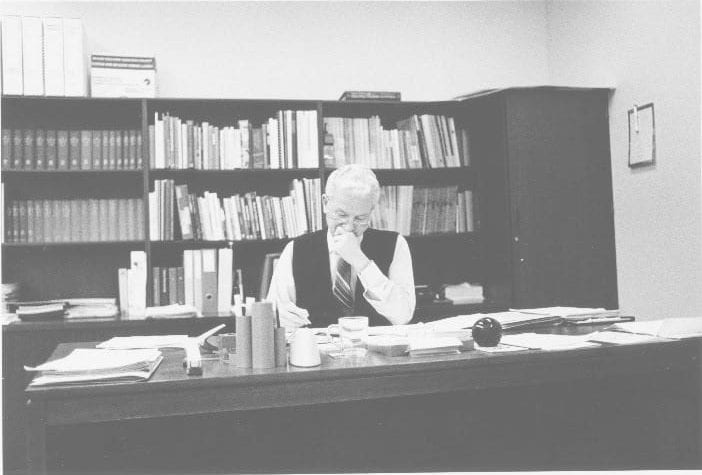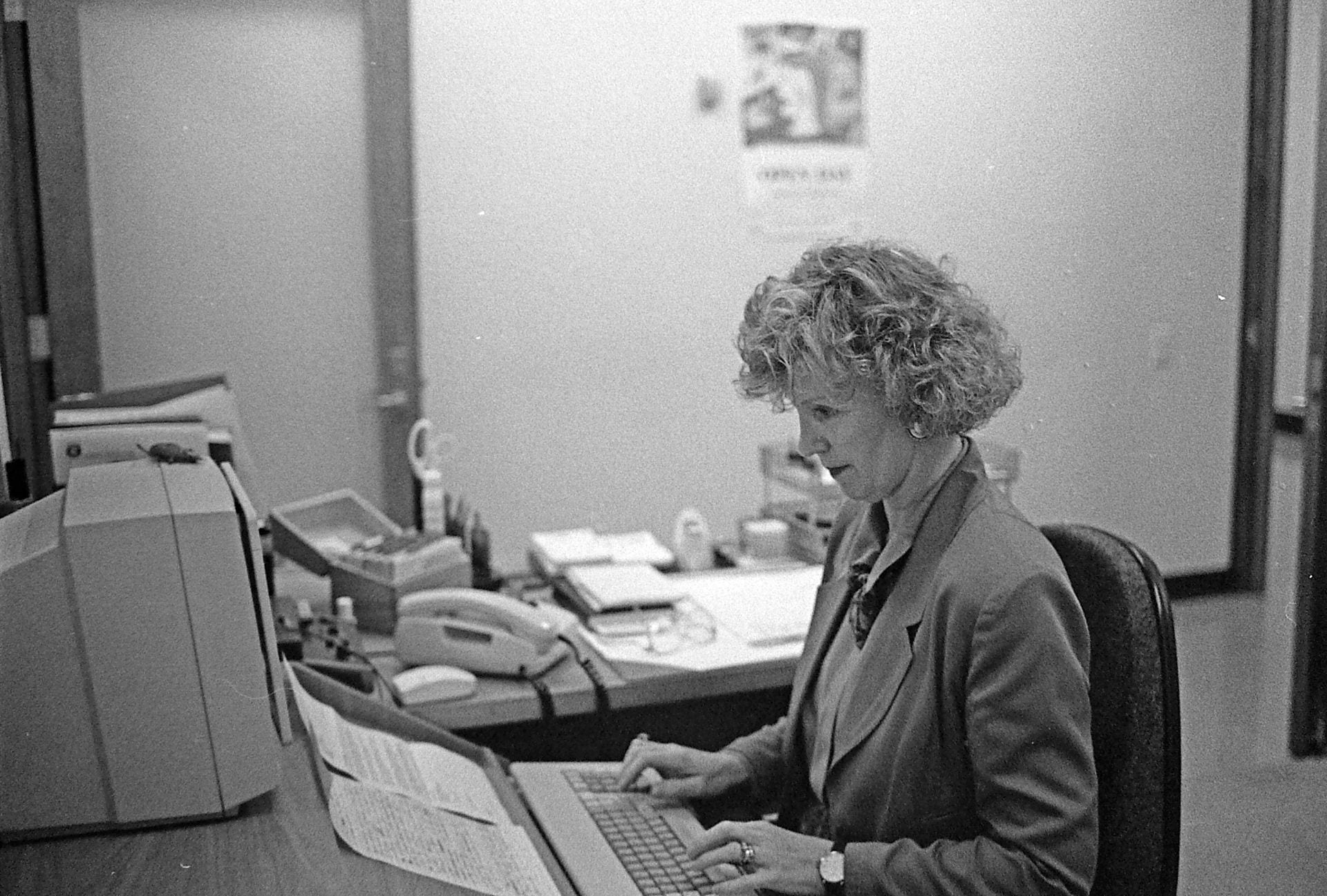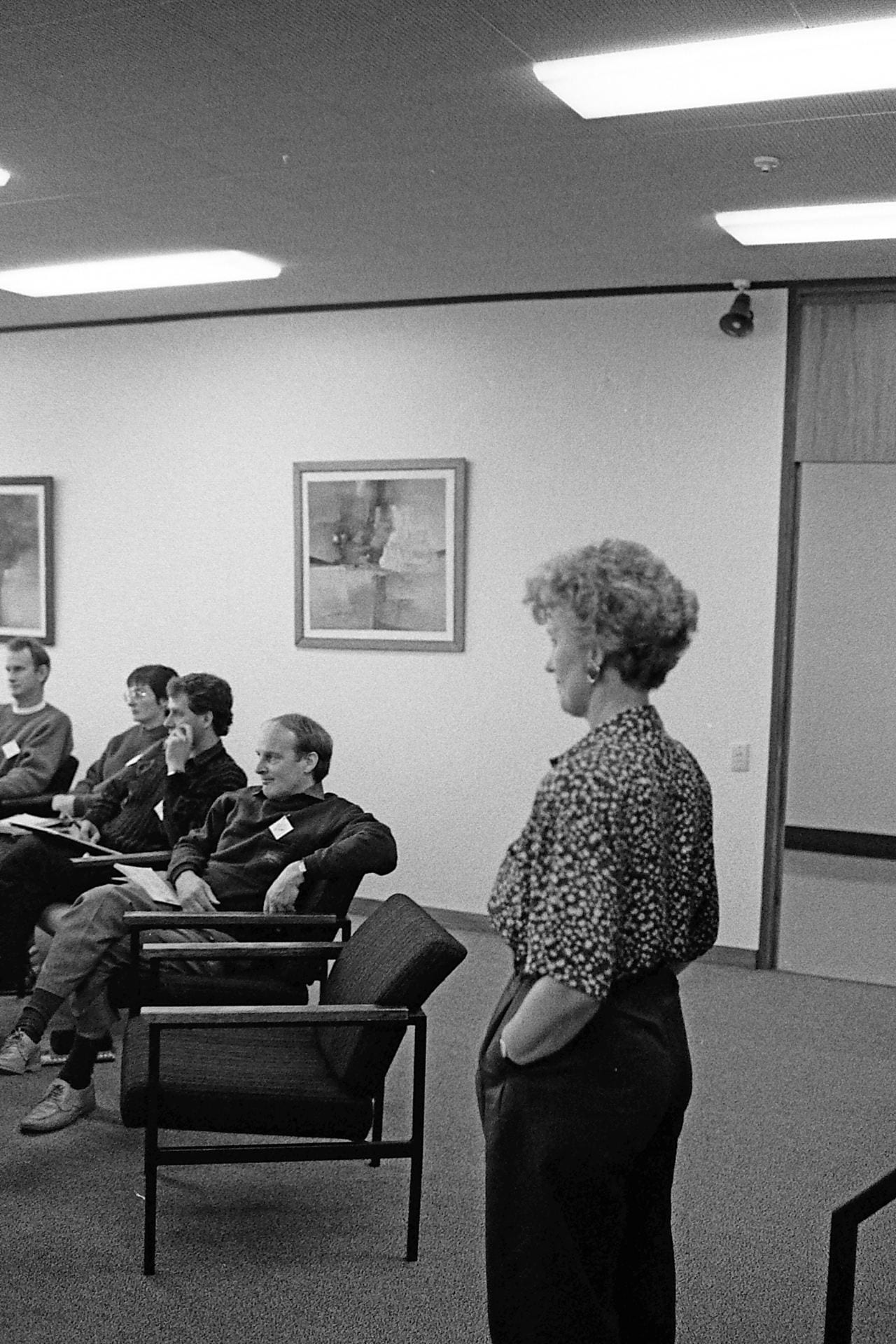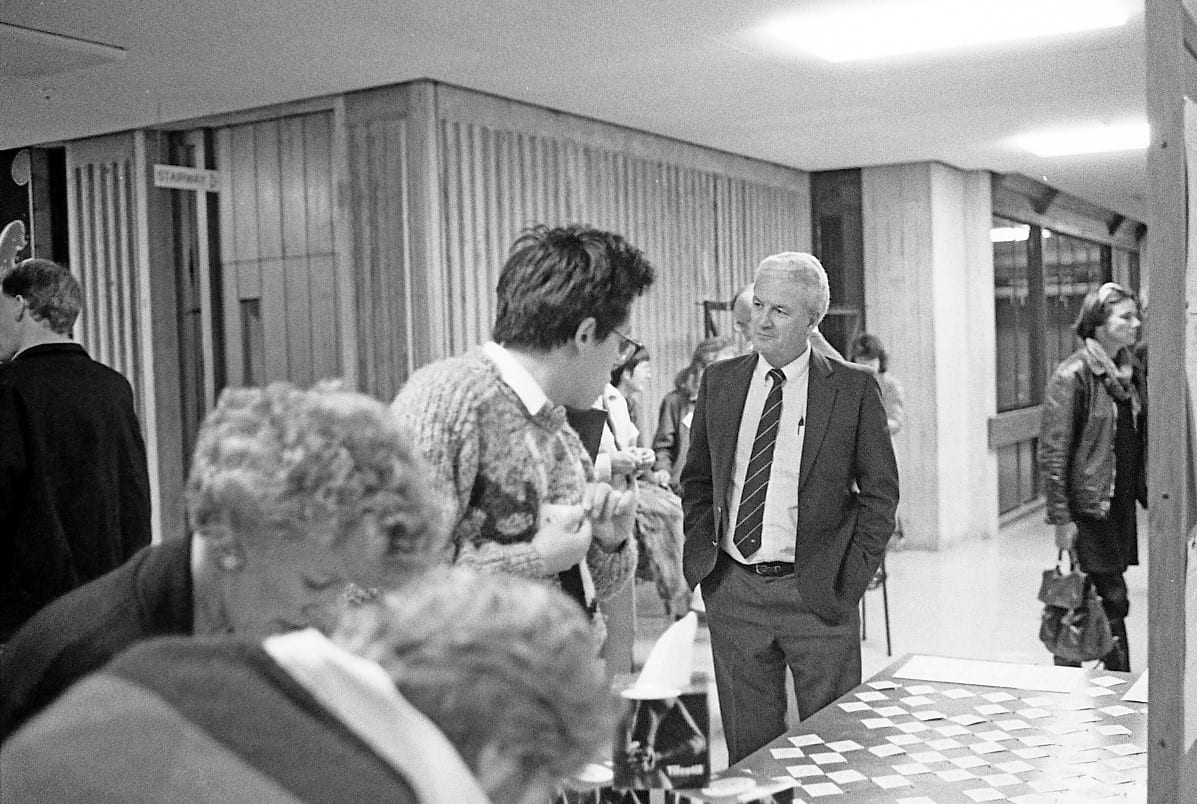Many of those who participated in oral history interviews for this project attribute the success of the Goodfellow Unit in its early years to the work of the inaugural Director, Dr Philip (Phil) Barham.
Current and former staff members cited Dr Barham’s approachability, emphasis on establishing personal connections with hundreds of GPs, and determination to create lessons that were of immediate relevance to the daily working lives of GPs as among the key reasons. Dr Campbell Maclaurin, who first proposed the appointment of a Director of continuing medical education, remained responsible for the Unit within his role as Associate Dean of Graduate Studies in Medicine. He described Barham as the ‘absolute heart of soul of what I was wanting to achieve’.1
Campbell Maclaurin on Phil Barham
Dr Phil Barham, 1928-2012.
Dr Barham was one of three medical practitioners who responded to the University Council’s advertisement for The Sir William Goodfellow Director of Continuing Medical Education in General Practice within the Department of Graduate Studies in February 1978.2
Phil Barham was born in Dannevirke in 1928. He completed his medical training at the University of Otago and later gained his Diploma of Obstetrics from the University of Auckland. Barham had gained considerable experience in delivering postgraduate education by the time he applied for the position as Director. He had served as the Chair of the Postgraduate Committee of the Faculty Board of the New Zealand College of GPs, conducted short courses in manual therapy for his colleagues in Dargaville, and had lectured for the St John Ambulance Service.3
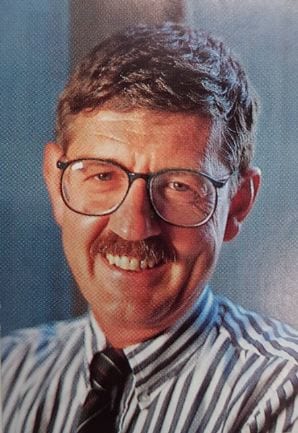
Brian McAvoy became the first Elaine Gurr Chair of General Practice at the University of Auckland’s School of Medicine in 1989
Dr Barham had also pursued his own continuing medical education. Dr Brian McAvoy accompanied Barham from Dargaville to a training course at Whangarei Base Hospital in 1977. Dr McAvoy was visiting New Zealand on his return to Scotland from Canada. He described the hour-long drive from Dargaville to Whangarei as ‘an indication of the vastness of New Zealand’ and his astonishment that a ‘GP continuing his education would drive from Dargaville to Whangarei just for an evening meeting and then back again’.4 Dr Barham’s pursuit of continuing medical education was especially noteworthy considering vocational training for GPs was just emerging at that time. There was even less sense of the need for continuing medical education among many medical graduates. Brian recalled it was almost a ‘rite of passage’ for medical graduates to burn all their textbooks because they had finished studying:
You were a doctor, you got your degree. That was one end of the spectrum. Some people really saw this as a process you had to go through for six years, but if you got your degree and you were a doctor then you could burn all your books. So there was no formal system of postgraduate training or continuing medical education. 5
Dr Barham commenced his position in September 1978. He became responsible for continuing medical education for GPs in the Auckland, Northland, and Waikato Regions. 6 This included assessing the educational needs of GPs, organising workshops and refresher courses, and fostering connections with the Royal New Zealand College of GPs, the New Zealand Council for Postgraduate Medical Education, and the Department of Health, among other groups interested in further education. 7
Yet as his role was the first of its kind in New Zealand, he noted there were ‘no precedents as to the nature of the job or its range of activity’.8 Barham took the lead from others interested in continuing medical education for GPs, namely Drs John Richards, Rae West, and Campbell Maclaurin, and looked to overseas training centres for inspiration. He proposed undertaking an overseas study tour to observe international developments that could be adapted for the New Zealand context. Upon Maclaurin’s recommendation, the Education Committee granted Barham a six-week leave of absence to explore continuing medical education in Switzerland, the UK, Canada, and in the United States.9


Dr Phil Barham (second from right, and front right beside Dr Rae West in 1981 or 1982) pictured with other members of The Royal New Zealand College of General Practitioners Council. Images supplied by West family.
Dr Barham was especially eager to learn about the continuing education needs of GPs in New Zealand. He observed that all prior efforts to gain insight into GPs’ perspectives required individual doctors to allocate time to completing and returning written questionnaires via post. Alternatively, he aimed to visit and establish personal connections with practising GPs to gain feedback about their individual situations and to assess ‘the whole spectrum’ of their involvement in continuing medical education. By May 1979, eight months after he had commenced his appointment, Barham had personally visited four hundred GPs in the Auckland and Northland regions.10
Many GPs were eager to learn more about the possibilities for continuing medical education. Yet some were considerably more skeptical about his objectives. Barham reported that ‘in a very few instances my reception has been cool but once they are convinced I am there to serve them not to criticise, then this reserve has always disappeared’.11
The endowment from Douglas Goodfellow in 1977 also provided the salary for a secretary. In April 1980, Ina Hamilton became the first administrative assistant of the Goodfellow Unit.12 GPs supported Phil Barham’s and Ina Hamilton’s endeavours by volunteering their time to contribute to developing, delivering, and attending the short courses.
Phil and Ina welcoming registrants at one of the short courses.
Across the early-1980s, Douglas Goodfellow also provided additional financial support for research officers. In August 1980, funding from the Sir William Goodfellow Trust and the Medical Education Trust enabled Barham to employ John Benseman to explore GPs’ perceptions of and engagement with continuing medical education.13 Two years later in 1982, Douglas Goodfellow funded the appointment of Mary Hepple who took responsibility for managing distance learning.14
Phil Barham retired in 1998 after twenty years as the Director of the Goodfellow Unit. By that time, the Unit had grown to a staff of twenty-eight who offered a range of on-site and distance courses, individual and group workshops for quality improvement, and undertook external contract work. Douglas Goodfellow hosted a dinner in August 1998 to honour Dr Barham’s retirement.15
While Phil Barham had initially planned to retire at the age of sixty-five in 1994, he agreed to remain in his position for another four years until the University appointed a replacement. Many expected Dr Jocelyn Tracey, the Assistant Director of the Goodfellow Unit, to take over Barham’s role. Yet the selection panel’s apparent refusal to offer Tracey a Professorship as was advertised, and rather the role of Director as an Associate Professor, disappointed many staff. Speaking with the New Zealand Doctor, one former staff member declared the Unit had ‘been taken over as a political football by the university’.16 Eight of the twenty-eight staff of the Goodfellow Unit resigned in a matter of months.17
- 1. Interview with Campbell Maclaurin, 11 September 2018. ↩
- 2. Letter from Campbell Maclaurin to Colin Maiden, 24 April 1978. ↩
- 3. Philip Barham, ‘Application for the Position of Director of Continuing Medical Education in General Practice’, February 1978. ↩
- 4. Interview with Brian McAvoy, 2 November 2018. ↩
- 5. Ibid. ↩
- 6. Letter from Campbell Maclaurin to Colin Maiden, 24 April 1978. ↩
- 7. The University Council, ‘The Sir William Goodfellow Director of Continuing Medical Education in General Practice’, advertisement, January/February 1978. ↩
- 8. Philip Barham, Application to the Logan Campbell Trust for an Overseas Study Tour, 27 June 1978. ↩
- 9. Letter from G. E. W. Thomas to Campbell Maclaurin, 18 July 1978. Letter from Campbell Maclaurin to Mr McIntryre, 22 June 1978. ↩
- 10. Letter from Philip Barham to Douglas Goodfellow, 4 May 1979. ↩
- 11. Philip Barham, Annual Report of the Sir William Goodfellow Director of Continuing Medical Education in General Practice, 31 December 1979, 3. ↩
- 12. Letter from B. M. Cocker, finance registry, to Douglas Goodfellow, 8 March 1983. ↩
- 13. Philip Barham and John Benseman, The General Medical Practitioner as a Lifelong Learner: Realities and Prospects. An Exploratory Study of Continuing Medical Education (CME) Among General Medical Practitioners in the University of Auckland Area (Auckland: Department of Postgraduate Affairs, University of Auckland, 1981), 1. ↩
- 14. Philip Barham, Annual Report of the Sir William Goodfellow Director of Continuing Medical Education in General Practice, 31 December 1982. ↩
- 15. Campbell Maclaurin, A History of the Development of the Goodfellow Unit, 1978-2003, unpublished document, 5. ↩
- 16. Kareen Floyd, ‘Goodfellow Fall Out’, New Zealand Doctor, 22 July 1998. ↩
- 17. Hugh Patterson, ‘First Health Grabs Goodfellows’, New Zealand Doctor, 9 June 1999. Hugh Patterson, ‘Pioneer Casts Off to Enjoy Family’, New Zealand Doctor, 5 August 1999. ↩

